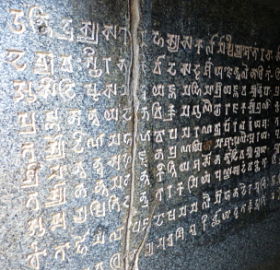11. Carry a Big Stick: Ancient Indian Political Thought
Two figures from the Mauryan dynasty, Kauṭilya and the king Aśoka, set out contrasting ideas about the ideal political rule.
Themes:
• R. Choudhary, Kautilya’s Political Ideas and Institutions (Varanasi: 1971).
• J. Gonda, Ancient Indian Kingship from the Religious Point of View (Leiden: 1966).
• N.A. Nikam and R. McKeon (trans.), The Edicts of Asoka (Chicago: 1966).
• P. Olivelle (ed.), Aśoka in History and Historical Memory (Delhi: 2009).
• P. Olivelle, King, Governance and Law in Ancient India: Kauṭilya’s Arthaśastra (Oxford: 2013).
• J.S. Strong, The Legend of King Aśoka (Princeton: 1983).
• R. Thapar, Aśoka and the Decline of the Mauryas (Oxford: 1961).
• A.A. Vigasin and A.M. Samozvantsev, Society, State and Law in Ancient India (New Delhi: 1985).

Origins


 ..
..



Comments
Buddha/stuupa
I have listened with great interest your podcast on Indian philosophy. Listening to the section on Buddha, I was surprised to hear you refer to 'stuupa' as a burial mound. Why would Ashoka have built thousands of burial mounds? Who/What was buried in these mounds.
The pre-Buddhist stuupas may have been burial mounds, but the Buddhist stuupas (to my knowledge) were never used to mark an interred body. The Buddhist stuupas did (and probaby still do) hold holy relics but no dead bodies. As, I am sure you know, the stuupas of Sanchi, Sarnath etc are large 'empty' spaces used for devotional purposes and meditation. Perhaps these should be called 'chaityas' with a stuupa
In reply to Buddha/stuupa by Prabhakar Gond…
Stupa
Thanks for the comment - obviously this isn't my area of expertise but from what I read I believe the idea is that stupas were indeed burial mounds, and continued to be built to house the bodies of Buddhist monks and nuns. However they could also house relics, so perhaps "reliquary" might be a better term (though for me that conjures up more the image of a jeweled container than an architectural structure, which is what we are talking about here),
In search of a search bar
I can always use Google or other third-party engines to search in the HOPWAG site. But I'm curious if an in-site search has been considered.
Also, did you (Peter Adamson) yourself build the site, or there's a team of engineers who handle the tech work, while you're focused on the writing and podcasting?
Finally, LMU Munich and KCL support this project, but have you also considered the Khan Academy-style nonprofit model to keep it going? Open to donations from individuals as well as philanthropic and research grants from univs.
In reply to In search of a search bar by Tarun G
In Search of Search
Actually as a moderator of the website I do have a search function, maybe we can think about making that available for everyone. The web designer is Julian Rimmer, he does all that technical stuff!
Thanks for the suggestion about the nonprofit - maybe a possibility for when I retire, but for now I have the backing of both universities so I am all set. (The costs are not crazy high anyway, podcasting is pretty cheap.)
Add new comment